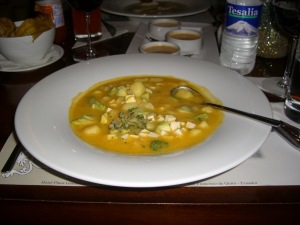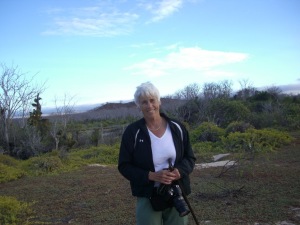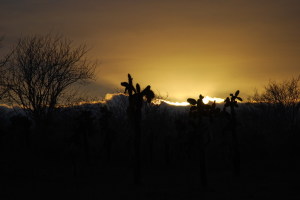I’m not convinced about Galapagos. Where are Darwin’s animals?
 There are certainly plenty of cactus – tall trees of Opuntia cactus (photo right) mixed in with sticky incense trees that those who live on Galapagos chain of islands actually use for incense for Catholic masses. Most of the shrub, gray to white sticks, green as summer sneaks in on the equator, so landscape looks as if there was once a major fire and these are the remnants waiting to resurrect. The Opuntia are fascinating: tall trunks with thousands of spines resembling hairy poles or a man who hasn’t shaved in weeks. Where the hairy part has exposed the real bark underneath, we learned it had artistic value – when a piece of it is held up to the sunlight, the normally dark reddish brown bark glows gold and mustard. Town’s craftsmen collect it to make eerie lamp shades. Hmm. On the Opuntia’s paddles are indentations as if a giraffe had bitten into them (there are no giraffe here). Such bite in the cactus flesh are put there by Galapagos finches.
There are certainly plenty of cactus – tall trees of Opuntia cactus (photo right) mixed in with sticky incense trees that those who live on Galapagos chain of islands actually use for incense for Catholic masses. Most of the shrub, gray to white sticks, green as summer sneaks in on the equator, so landscape looks as if there was once a major fire and these are the remnants waiting to resurrect. The Opuntia are fascinating: tall trunks with thousands of spines resembling hairy poles or a man who hasn’t shaved in weeks. Where the hairy part has exposed the real bark underneath, we learned it had artistic value – when a piece of it is held up to the sunlight, the normally dark reddish brown bark glows gold and mustard. Town’s craftsmen collect it to make eerie lamp shades. Hmm. On the Opuntia’s paddles are indentations as if a giraffe had bitten into them (there are no giraffe here). Such bite in the cactus flesh are put there by Galapagos finches.
Opuntia Cactus
In my first official outing, Dragon Hill on Santa Cruz Island, finished so late it was pitch dark by the time we – the last group – hiked back to our Zodiac. We encountered only a taste of Galapagos’ glories – the black marine iguanas swimming in for the night and feeding on low succulent ground covers; one orangie-yellow-green male land iguana, huge, hanging out in front of his well dug hole, and a pair of dull gray female ones at their holes where they’d normally lay eggs, hang two or three days, and then leave the offspring in the hands of God. That was it. We saw a pool of water where there should have been one or two flamingos (Flamingos here fly in skimpy groups or alone, not in mass as in Atacama or on Lake Manyara in Tanzania) and also saw where sea turtles had once laid their eggs in sand. We were rightly admonished not to tread through the beds. Any human touch could cause mothers to reject the eggs and homes. Stay clear. Don’t touch the animals. Don’t go near the animals. But so far, there haven’t been many animals to go close to.
For me, the oddity and joy of Galapagos was always the landscape and the sun happened to set for a good photograph while my group was strolling over red soil, red and black volcanic rock balancing ourselves on our walking sticks as we skirmished over stones in our paths.
The Explorer II (no relation to the sunken Explorer by a long shot in appearance or spirit) is a fancy ship that holds 100 customers mostly hoping for mild excursions into the dry lands and wet sea. Few seem to be in condition to hike on rock or any radical levels required to get to the beasts of Darwin’s memory nor to get in and out of the rubber Zodiacs. I guess I am unfair a judge. The Explorer II Zodiacs are driven at a snails pace whereas the Endeavor Zodiacs in Antartica were speed boats with a purpose not wasting a moment’s time while we all huddled together in the cold and waited for the next snow and ice landing.
Here the air is warm and sea temperature is in the high 60ties. Swimmers complain that it is freezing. Our guides are Ecuadorian – Spanish the natural language – and knowledgeable. But the groups are large and cumbersome, divided by kindergarten categories: Penguins, Dolphins, Albatrosses, Gaviotas (sea gulls), which is my group. They should have been categoried by abilities to move, hike, swim, and walk speedily so one wouldn’t suffer the aches, complaints and pains of others who seem to be terrified holding their giant cameras. Of course, I’m not a good example. I walk fast as the wind when I’m on the flat. Even my grandchildren trying to keep up with me once on New York City sidewalks invented what they called the “Nana Walk.” However here, I need exercise, badly, and there are no challenging climbs nor even kayaking trips offered or tortoise kissing, as publicized on brochures.
One night in Quito, Ecuador
Quito is about 7000 feet high and sunken into hills and mountains like a blanket tossed on rough ground for a picnic. The poverty and lack of urban design to go with this huge urban sprawl is overwhelming. The shacks press one to another, the stores and offices, all barred with iron, are given a lift by being painted a color, although a repaint of the entire city might bring it more to life. Ironically, the Horwl Plaza Grande is probably one of the best hotels I’ve visited in my life. It’s one of the oldest hotels restored to a glamorous and high elegance and sits on a popular plaza along with the Presidential Palace and government offices in the antique colonial style.
The cheerful doorman was the first black person I’d seen since I left home. The hotel and rooms are filled with dreamy Christmas decorations and a melange of pastries and chocolates beside a bottle of champagne and a napkin, and Christmas carols are piped through the intercom. The hotel boasts a “criollo” restaurant, which means a place to eat true Ecuadorian food. The helpings are huge, and when I asked the waiter with his black cap and jacket why so much food, he answered to give us a feeling of eating good home cooking, and in home kitchens of Ecuador, food is generous.
 I tried cerviche (served in a huge china bowl thick with all kinds of crustaceans in a broth to die for), potato soup made with a maize base and chunks of potatoes, cheese and avocado. Dessert was quimbolitos, a sweet maize pudding wrapped in banana leaves and served with a touch of red fruits in a berry sauce. Yum.
I tried cerviche (served in a huge china bowl thick with all kinds of crustaceans in a broth to die for), potato soup made with a maize base and chunks of potatoes, cheese and avocado. Dessert was quimbolitos, a sweet maize pudding wrapped in banana leaves and served with a touch of red fruits in a berry sauce. Yum.
Galapagos migrants – many – filled Quito’s airport yesterday morning when I checked in. Lines were long but moved quickly. I was rather put off by the lack of information given us at the airport or by the Galapagos organizers – I still had no idea how the system worked or really where I was going but we flew in a Central American airline.
 Photo: Seals are not interested in us on arrival in Galapagos.
Photo: Seals are not interested in us on arrival in Galapagos.
When we climbed down from the non-luxurious buses that had grabbed us as we disembarked from the plane in Baltra, a tiny pueblo in the dry brown earth of one small Galapagos island, we were taken to a dock that was occupied by a dozen lazy and noisy seals, one on top of the other, not at all interested in these masses of perfumed animals lining up in their city clothes to take the Zodiacs to our ship anchored in the bay. (There were about six Zodiacs). As we put on our life crude yellow and blue jackets, many passengers were, I believe, in shock as I was as they discovered they had to load up carry on luggage and folded city-slicker jackets in their laps as they balanced on the rubber border of the Zodiac. How were we to get in that with this? Water splashed one lady, got her shorts a bit wet, and she was furious. Well, thems are the breaks when over 120,000 tourists have to be handled a year. I can see why the port-lounging seals were non-chalant about the invasion.
Now here’s the kicker. I thought Galapagos belonged completely to Darwin’s mammals, reptiles, birds, and cactus. Wrong. There are four pueblos on these islands with 30,000 residents, 15,000 in one town alone. I had imagined a picturesque, pristine, sacred environment reserved only for nature and maybe one or two scientific study stations. The parks do put up lots of rules strictly enforced such as don’t take rocks or sand with you. Don’t touch any of the animals – if you have sun screen on your fingertips, the odor from that salve would be transferred to, for instance, a baby seal or turtle, and the mother would then abandon it. Not a good thing.
But still, be positive: there’s lessons to be learned and animals to meet. It must get better. I’m ready for a hike and a snorkel.



